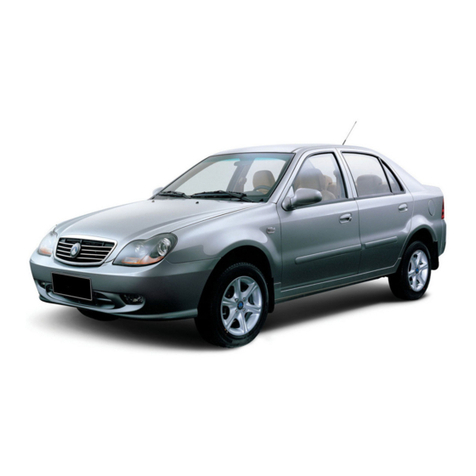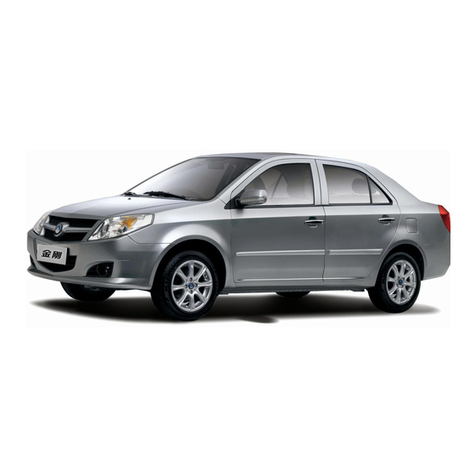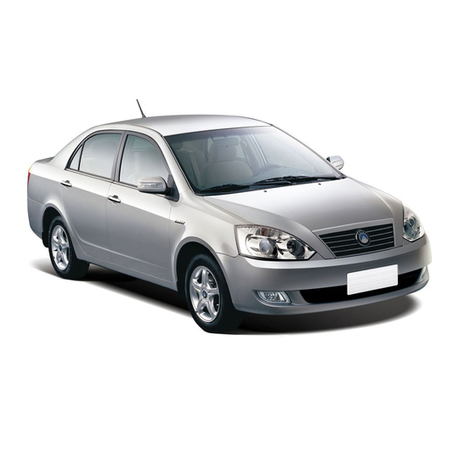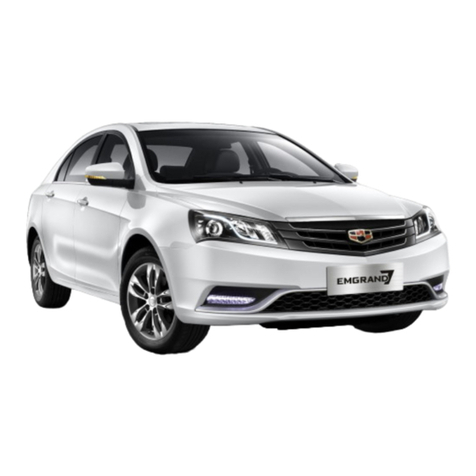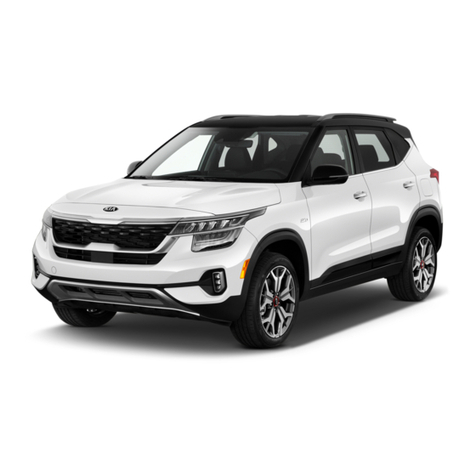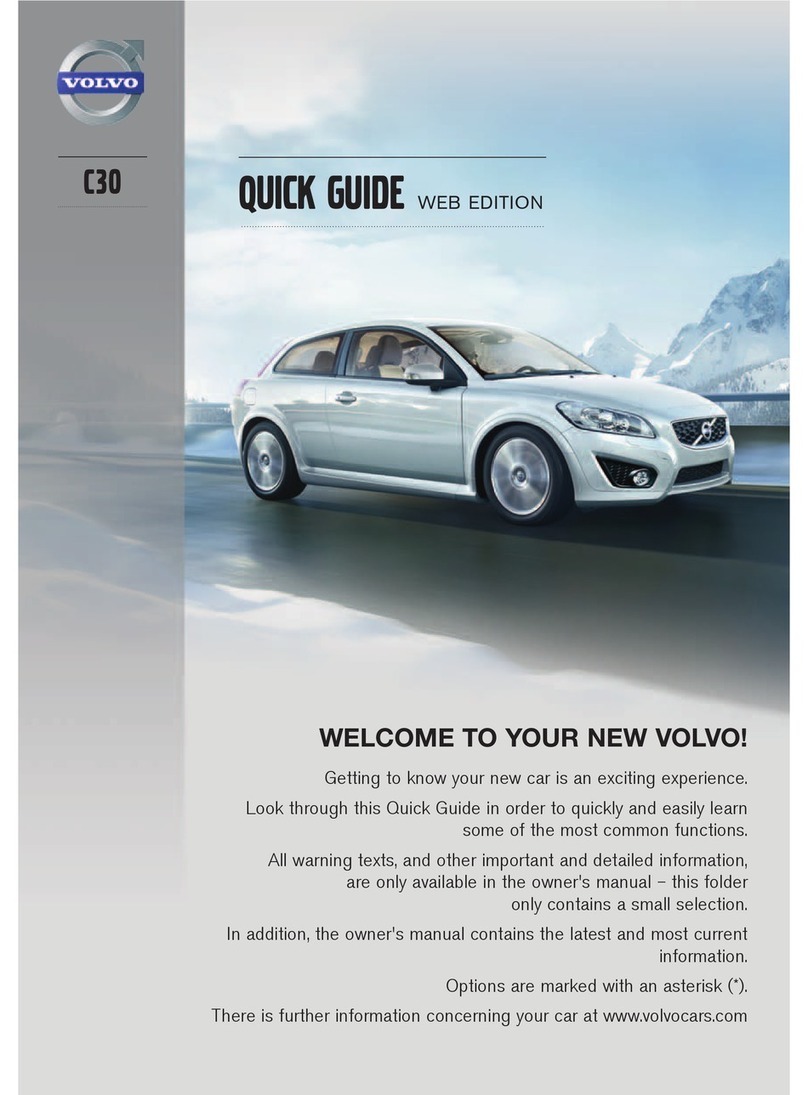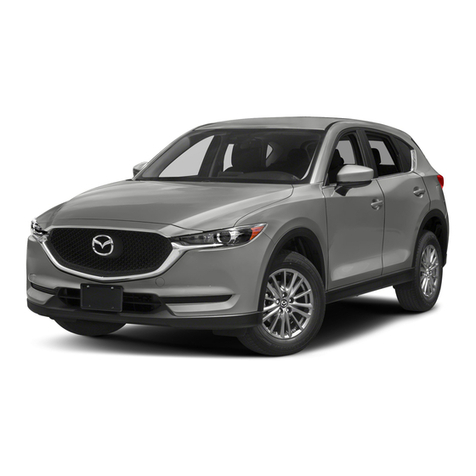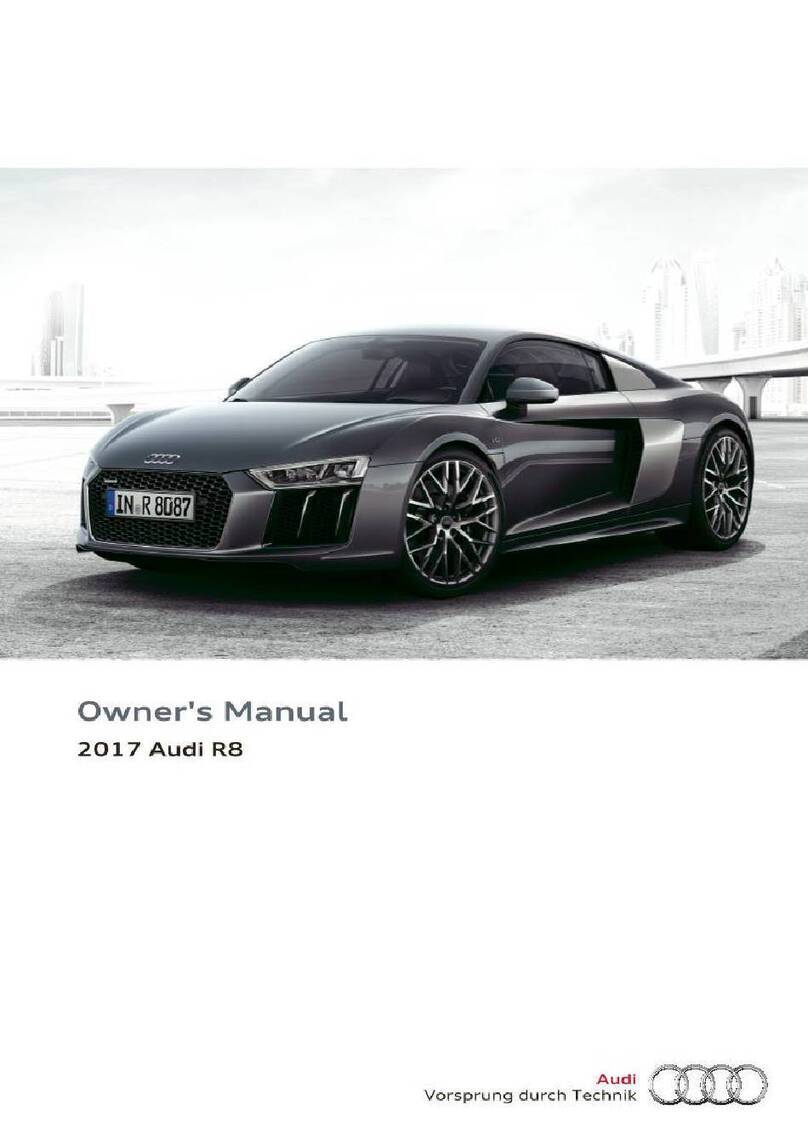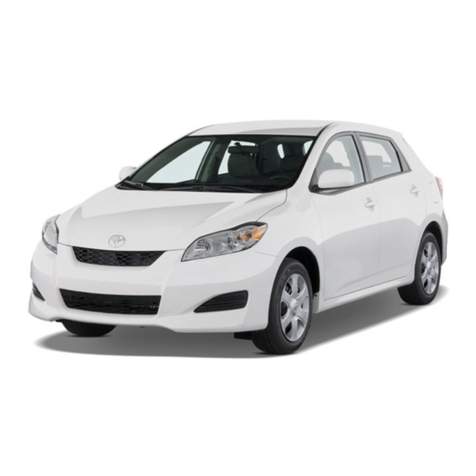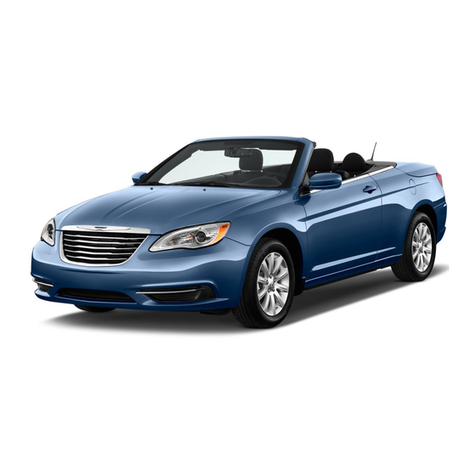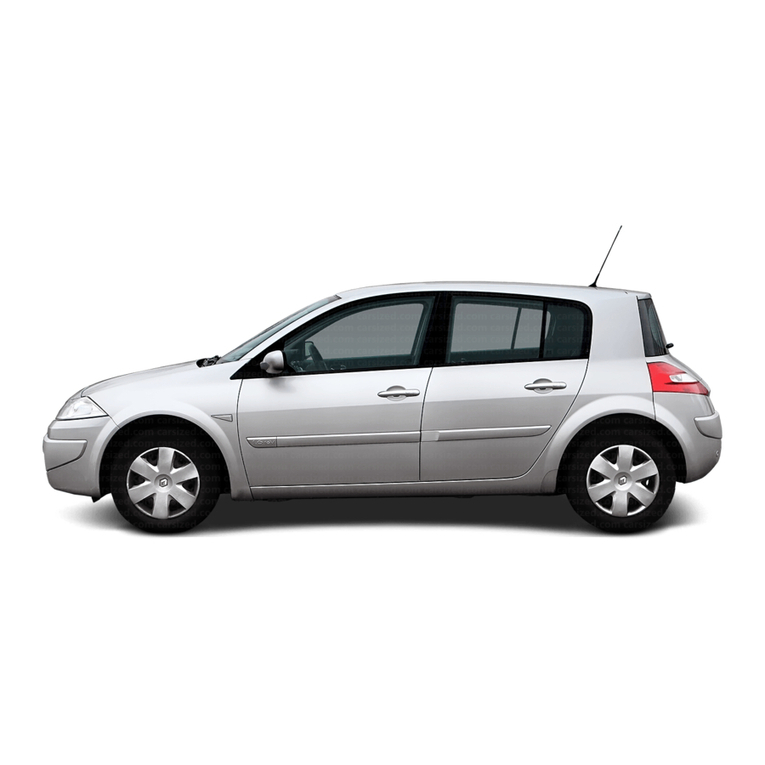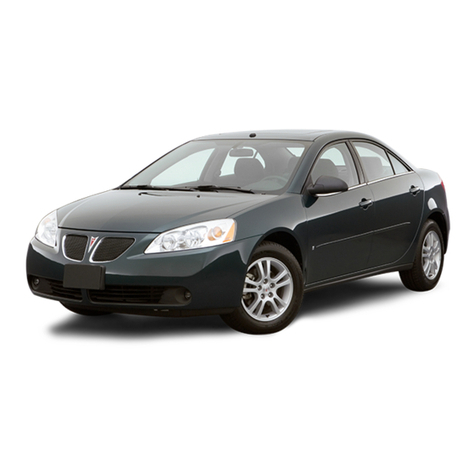Geely EC718 2009 Instruction manual

2009
Geely EC718 , EC718RV and
EC715, EC715RV Workshop
Manual
This workshop manual provides model year 2009 EC718/EC718RV and EC715/
EC715RV models specification, diagnostic and service information.
2009 Geely Automotive Co., Ltd.
All rights reserved
Information as of the date of October 2009
Without written permission from Geely Automotive Co., Ltd., any form or means (including, but not limited to, electronic
duplicating, photocopying, scanning and recording) of copying, storing or distribution of any part or the whole manual is not
allowed.

Preface
This is EC718/EC718RV and EC715/EC715RV workshop manual. Please refer to the index to retrieve the section you need.
Models EC718/EC718RV and EC715/EC715RV
Please note that the following publication is also for the related components and systems maintenance. "
Manual Name Publication Number
EC718/EC718RV and EC715/EC715RV Wiring Diagram
All the information in this manual is based on the latest products available at the time of publishing. The specifications and the repair
procedures may change without prior notice.
It is recommended that you contact Geely Automotive Co., Ltd. to obtain the information about the products, part numbers or special
tools referred in this manual.
If there are any omissions or mistakes, please contact Geely Automotive Co., Ltd. to amend.
(c) 2009 Geely Automotive Co., Ltd.
Copyright
Without written permission from Geely Automotive Co., Ltd., this manual may not be replicated in whole or part.

Warnings
This manual does not include all the repair information required. It is for experienced and qualified personnel. A non-professional
or non-qualified technician using the manual or not having the appropriate equipment and tools for repair, it may cause serious
personal injury or damage to the vehicle.
To prevent personal injury or damage to the vehicles, please make sure follow the instructions below.
–Carefully read through this manual. Fully understanding of "Warnings and Notices" in the "Overview" section is particularly
important.
–Repair procedures described in this manual is helpful for the repair work. When following the repair procedures in this manual,
make sure use the recommended tools. If using tools other than recommended or not following the repair procedures, prior to
commencing repair, ensure the safety of technical personnel and prevent personal injury or damage to customer vehicles.
–When replacing parts, please use parts approved by Geely Automotive Co., Ltd. with the same part numbers. Do not use inferior
parts.
–To reduce the risk of causing bodily harm and to reduce the possibilities of causing vehicle damage, please strictly follow all the
warnings and notes. It is also important to realize that the "Warning" and the "Note" are not exaggerated. Non-compliance may
lead to dangerous consequences.
–Before repairing the airbag system components or working in the vicinity of airbag system, please refer to the "Airbag system
component Locator" in the "Safety" section and the "Wiring Harness Routing Views" in the Wiring Diagram. Understand the
airbag system components locations on a vehicle. Strictly follow all of the contents in the "Warnings and Notices". Violating these
will result in airbag deployment, personal injury or to unnecessary airbag system repair.


Main table of contents
Preface.................................................................2
Warnings...............................................................3
Table of Contents.................................................5
Part One Vehicle Overview
1 Vehicle Overview............................................1-1
1.1 Warnings and Notices...............................................1-3
1.2 Vehicle Inspection...................................................1-11
1.3 Lifting and Jacking the Vehicle...............................1-14
1.4 Maintenance...........................................................1-18
1.5 Service Information System....................................1-26
1.6 Health and Safety...................................................1-28
1.7 Standards and Metrics............................................1-33
1.8 Vehicle Specifications.............................................1-37
1.9 Vehicle Identification Number.................................1-58
1.10 Noise, Vibration and Abnormal Sound..................1-66
1.11 Water Leaks..........................................................1-69
1.12 Special Tools........................................................1-71
Part Two Power System
2 Engine............................................................2-1
2.1 Warnings and Notices...............................................2-9
2.2 Control System JL4G18-D......................................2-11
2.3 Fuel System JL4G18-D........................................2-222
2.4 Auxiliary Emission Control JL4G18-D...................2-257
2.5 Engine Anti-theft System JL4G18-D.....................2-274
2.6 Engine Mechanical System JL4G18-D.................2-299
2.7 Exhaust System JL4G18-D..................................2-429
2.8 Cooling System JL4G18-D...................................2-455
2.9 Lubricating System JL4G18-D..............................2-499
2.10 Ignition System JL4G18-D..................................2-517
2.11 Starting / Charging System JL4G18-D...............2-547
2.12 Control System JL4G15-D..................................2-585
2.13 Fuel System JL4G15-D......................................2-797
2.14 Auxiliary Emission Control JL4G15-D.................2-811
2.15 Engine Anti-theft System JL4G15-D...................2-817
2.16 Engine Mechanical Systems JL4G15-D.............2-823
2.17 Exhaust System JL4G15-D................................2-835
2.18 Engine Cooling System JL4G15-D.....................2-837
2.19 Lubrication System JL4G15-D............................2-854
2.20 Ignition System JL4G15-D..................................2-856
2.21 Starting / Charging System JL4G15-D...............2-871
3 Transmission / Drive Axle...............................3-1
3.1 Warnings and Notices...............................................3-3
3.2 Clutch System...........................................................3-4
3.3 Manual Transmission..............................................3-27
Part Three Chassis
4 Suspension System........................................4-1
4.1 Warnings and Notices...............................................4-3
4.2 Front Suspension......................................................4-4
4.3 Rear Suspension....................................................4-35
4.4 Wheels and Tires....................................................4-53
5 Transmission / Axle........................................5-1
5.1 Warnings and Notices...............................................5-2
5.2 Differential.................................................................5-3
5.3 Drive Shaft System.................................................5-12
6 Brake System.................................................6-1
6.1 Warnings and Notices...............................................6-3
6.2 Front Brake...............................................................6-4
6.3 Rear Brake..............................................................6-18
6.4 Hydraulic Brake......................................................6-29
6.5 Parking System.......................................................6-51
6.6 ABS / TCS / EBD / ESP..........................................6-69
6.7 TPMS....................................................................6-101
7 Steering System.............................................7-1
7.1 Warnings and Notices...............................................7-2
7.2 Hydraulic Power Steering System............................7-3
7.3 Steering Wheel and Steering Column....................7-38
Part Four Electrical Equipment
8 Heating, Ventilation and A/C System.............8-1
8.1 Warnings and Notices...............................................8-2
8.2 Automatic Air-conditioning........................................8-3
9 Safety Protection Device................................9-1
9.1 Warnings and Notices...............................................9-2
9.2 Airbag System..........................................................9-3
9.3 Pretension Seat Belt System..................................9-43
10 Vehicle Control System..............................10-1
10.1 Warnings and Notices...........................................10-2
10.2 Computer / Integrated Systems............................10-3
10.3 Programming and Set Up...................................10-23
Main table of contents 5
EC718/EC718RV EC715/EC715RV 10/2009

11 Body Electric...............................................11-1
11.1 Warnings and Notices...........................................11-9
11.2 Audio Entertainment System..............................11-10
11.3 Navigation...........................................................11-37
11.4 Lighting System..................................................11-61
11.5 Glasses / Windows / Mirrors.............................11-153
11.6 Wipers / Washers System................................11-215
11.7 Instrument / Driver Information System............11-272
11.8 Sunroof.............................................................11-301
11.9 Central Locking.................................................11-326
11.10 Remote Anti-theft System...............................11-371
11.11 Electric Seats..................................................11-398
11.12 Defrosting.......................................................11-432
11.13 Horn................................................................11-447
11.14 Reverse Radar................................................11-461
11.15 Instrument Cluster..........................................11-488
11.16 Cigarette Lighter.............................................11-499
11.17 Data Communication System.........................11-513
Part Five Body
12 Body, Sheet Metal and Painting.................12-1
12.1 Warnings and Notices...........................................12-4
12.2 Body Front End.....................................................12-5
12.3 Body Rear End...................................................12-13
12.4 Bumpers.............................................................12-27
12.5 Doors..................................................................12-38
12.6 Frame and Underbody........................................12-44
12.7 Seats...................................................................12-53
12.8 Instrument Panel, Gages and Console...............12-61
12.9 Interior Trim........................................................12-70
12.10 Exterior Trim.....................................................12-97
12.11 Plastic Panel Information and Repair.............12-109
12.12 Collision Repair...............................................12-112
12.13 Paint/Coatings................................................12-157
6 Main table of contents
EC718/EC718RV EC715/EC715RV 10/2009

1 Vehicle Overview
1.1 Warnings and Notices.....................1-3
1.1.1 Description and Operation........................1-3
1.1.1.1 Warnings and Notices........................................1-3
1.2 Vehicle Inspection.........................1-11
1.2.1 Description and Operation......................1-11
1.2.1.1 Inspection Items Before Operating The Vehicle...1-
11
1.2.1.2 Inspection Items Before Each Time Filling Fuel...1-
11
1.2.1.3 Monthly Inspection Items..................................1-11
1.2.1.4 Inspection Items At Least Twice A Year...........1-11
1.2.1.5 Inspection Items When Changing Engine Oil.......1-
12
1.2.1.6 Inspection Items At Least Once A Year...........1-12
1.3 Lifting and Jacking the Vehicle......1-14
1.3.1 Description and Operation......................1-14
1.3.1.1 Lifting and Jacking the Vehicle.........................1-14
1.4 Maintenance..................................1-18
1.4.1 Specifications.........................................1-18
1.4.1.1 Oil and Fluid Capacity......................................1-18
1.4.1.2 Recommended Oil and Lubricants...................1-18
1.4.2 Description and Operation......................1-19
1.4.2.1 Oil Maintenance Schedule...............................1-19
1.4.2.2 Normal Driving Condition Service Schedule....1-19
1.4.2.3 Harsh Driving Condition Service Schedule......1-21
1.4.2.4 Regular Service Instructions............................1-22
1.4.2.5 Tire Rotation Description..................................1-23
1.5 Service Information System..........1-26
1.5.1 Description and Operation......................1-26
1.5.1.1 Abbreviations Used In This Manual..................1-26
1.5.1.2 Arrows and Symbols Description.....................1-27
1.6 Health and Safety..........................1-28
1.6.1 Description and Operation......................1-28
1.6.1.1 Description.......................................................1-28
1.6.1.2 Acid and Alkali..................................................1-28
1.6.1.3 Airbag...............................................................1-28
1.6.1.4 Air-Conditioning Refrigerant.............................1-29
1.6.1.5 Adhesives and Sealants...................................1-29
1.6.1.6 Engine Coolant.................................................1-29
1.6.1.7 Asbestos...........................................................1-29
1.6.1.8 Battery Acid Fluid.............................................1-29
1.6.1.9 Brake Fluid.......................................................1-29
1.6.1.10 Chemical Materials.........................................1-29
1.6.1.11 Dust................................................................1-30
1.6.1.12 Electrical Shock..............................................1-30
1.6.1.13 Exhaust..........................................................1-30
1.6.1.14 Fiber Isolation.................................................1-30
1.6.1.15 Fire.................................................................1-31
1.6.1.16 First Aid..........................................................1-31
1.6.1.17 Foam - Polyurethane......................................1-31
1.6.1.18 Fuel................................................................1-31
1.6.1.19 Gas Cylinder...................................................1-31
1.6.1.20 General Workshop Tools and Equipment......1-32
1.6.1.21 Lubricants and Grease...................................1-32
1.6.1.22 Noise..............................................................1-32
1.7 Standards and Metrics..................1-33
1.7.1 Description and Operation......................1-33
1.7.1.1 Equivalent - Decimal and Metric.......................1-33
1.7.1.2 US English/Metric Units Conversion................1-35
1.8 Vehicle Specifications...................1-37
1.8.1 Specifications.........................................1-37
1.8.1.1 Body Size.........................................................1-37
1.8.1.2 Fastener Specifications....................................1-43
1.9 Vehicle Identification Number.......1-58
1.9.1 Description and Operation......................1-58
1.9.1.1 Vehicle Identification........................................1-58
1.9.1.2 Vehicle Identification Number (VIN) Description..1-
58
1.9.1.3 Compliance Label.............................................1-63
1.9.1.4 Tire Placard......................................................1-64
1.9.1.5 Engine Serial Number and its Location............1-64
1.9.1.6 Manual Transmission Serial Number and its
Location........................................................................1-64
Vehicle Overview Table of Contents 1-1
EC718/EC718RV EC715/EC715RV 10/2009

1.10 Noise, Vibration and Abnormal Sound
............................................................1-66
1.10.1 Description and Operation....................1-66
1.10.1.1 Diagnostic Information and Procedures.........1-66
1.10.1.2 Repair.............................................................1-67
1.11 Water Leaks................................1-69
1.11.1 Description and Operation....................1-69
1.11.1.1 Diagnostic Information and Procedures.........1-69
1.11.1.2 Repair.............................................................1-69
1.12 Special Tools...............................1-71
1.12.1 Special Tools and Equipment...............1-71
1.12.1.1 Power Train Special Tools.............................1-71
1.12.1.2 Chassis and Body Special Tools....................1-76
1-2 Table of Contents Vehicle Overview
EC718/EC718RV EC715/EC715RV 10/2009

1.1 Warnings and Notices
1.1.1 Description and Operation
1.1.1.1 Warnings and Notices
Definition of the "Warning", "Notice" and "Note"
Diagnostic and repair procedures include general and specific,
two types of "Warning", "Notice" and "Note". Geely is
committed to provide information to assist service technicians
with diagnostic and repair and to restore the vehicle to normal
running condition. However, if the technician does not follow
the recommended procedures, certain procedures may cause
danger to the technician.
"Warning", "Notice" and "Note" are to prevent the occurrence
of such danger. Not all risks are foreseeable. They are at
apparent locations in the workshop manual. This information is
prepared to prevent the following cases:
–Severe personal injury
–Vehicle damage
–Unnecessary vehicle repair
–Unnecessary replacement of parts
–Improper vehicle repair or part replacement
Definition of "Warning"
A "Warning" means a procedure must be taken or a prohibited
procedure. If a "warning" is ignored, it may have the following
consequences:
–Severe personal injury
–If a vehicle is not properly repaired, it may cause severe
personal injury to the driver and / or passengers.
Definition of "Notice"
"Notice" requires to pay special attention to a must taken
procedure or a prohibited procedure. If a "Notice" is ignored, it
may have the following consequences:
–Vehicle damage
–Unnecessary vehicle repair
–Unnecessary replacement of parts
–Improper operation of the repaired systems or components
–Damage to related systems or components
–Damaged to fasteners, tools or special tools
–Engine coolant, lubricants, or other fluid leak
Definition of "Note"
"Note" states the importance of a diagnostic procedure or the
need". The purpose of the "Note" is as following:
–Clarify the procedures
–Provide additional information for completing a procedure
–Clarify the recommended procedures for operational
reasons
–Provide help for technicians to complete the repair more
efficiently
–Provide experience to technicians to complete the repair
more easily
Vehicle Lifting Warning
Warning: To avoid any vehicle damage, serious personal injury
or death when major components are removed from the vehicle
and the vehicle is supported by a hoist, support the vehicle with
jack stands at the opposite end from which the components are
being removed and strap the vehicle to the hoist.
ABS Component Handling Warning
Warning: Certain components in the Anti-lock Brake System
(ABS) are not intended to be serviced individually. Attempting
to remove or disconnect certain system components may result
in personal injury and/or improper system operation. Only
those components with approved removal and installation
procedures should be serviced.
Approved Equipment for Collision Repair
Warning
Warning: To avoid personal injury when exposed to welding
flashes or to galvanized (Zinc Oxide) metal toxic fumes while
grinding/cutting on any type of metal or sheet molded
compound, you must work in a properly ventilated area,
wearing an approved respirator, eye protection, earplugs,
welding gloves, and protective clothing.
Assistant Driving Warning
Warning: An assistant should drive the vehicle while the
technician checks for the location of the reported condition.
Otherwise, personal injury could result.
Vehicle Overview Warnings and Notices 1-3
EC718/EC718RV EC715/EC715RV 10/2009

Battery Disconnect Warning
Warning: Unless directed otherwise, the ignition and start
switch must be in the OFF or LOCK position, and all electrical
loads must be OFF before servicing any electrical component.
Disconnect the negative battery cable to prevent an electrical
spark should a tool or equipment come in contact with an
exposed electrical terminal. Failure to follow these precautions
may result in personal injury and/or damage to the vehicle or
its components.
Warning: If repair an airbag, the battery negative cable must
be disconnected at least 90s before carry out operations.
Brake Dust Warning
Warning: Avoid taking the following actions when you service
wheel brake parts:
–Do not grind brake linings.
–Do not sand brake linings.
–Do not clean wheel brake parts with a dry brush or with
compressed air.
Warning: Some models or aftermarket brake parts may contain
fibers which can become airborne in dust. Breathing dust with
fibers may cause serious bodily harm. Use a water-dampened
cloth in order to remove any dust on brake parts. Equipment is
available commercially in order to perform this washing
function. These wet methods prevent fibers from becoming
airborne.
Brake Fluid Warning
Warning: Do not use fluid from an open container that may be
contaminated with water. Incorrect or contaminated fluid could
result in system failure, loss of vehicle control and personal
injury.
Brake Fluid Irritant Warning
Warning: Brake fluid may be irritating to the skin or eyes. In
case of contact, take the following actions:
–Eye contact--rinse eyes thoroughly with water.
–Skin contact--wash skin with soap and water.
Brake Pipe Replacement Warning
Warning: Carefully route and retain replacement brake pipes.
Always use the correct fasteners and in the original location for
replacement brake pipes. Failure to properly route and retain
brake pipes may cause damage to the brake pipes and brake
system resulting in personal injury.
Breathing R-134a Warning
Warning: Avoid breathing the A/C Refrigerant 134a (R-134a)
and the lubricant vapor or the mist. Exposure may irritate the
eyes, nose, and throat. Work in a well ventilated area. In order
to remove R-134a from the A/C system, use service equipment
that is certified to meet the requirements of SAEJ2210 (R-134a
recycling equipment). If an accidental system discharge
occurs, ventilate the work area before continuing service.
Additional health and safety information may be obtained from
the refrigerant and lubricant manufacturers.
Clutch Dust Warning
Warning: When servicing clutch parts, do not create dust by
grinding or sanding the clutch disc or by cleaning parts with a
dry brush or with compressed air. A water-dampened cloth--
NOT SOAKED--should be used. The clutch disc may contain
fibers which can become airborne if dust is created during
servicing. Breathing dust with fibers may cause serious bodily
harm.
Collision Sectioning Warning
Warning: Sectioning should be performed only in the
recommended areas. Failure to do so may compromise the
structural integrity of the vehicle and cause personal injury if
the vehicle is in a collision.
Cracked Window Warning
Warning: If a window is cracked but still intact, crisscross the
window with masking tape in order to reduce the risk of damage
or personal injury.
Exhaust Service Warning
Warning: In order to avoid being burned, do not service the
exhaust system while it is still hot. Service the system when it
is cool.
Express Window Down Warning
Warning: Disconnect the power window switch when working
inside the driver door. When operated, the Express Up/Down
Feature allows the door window to move very quickly, without
stopping, which could cause personal injury.
Eye Protection Warning
Warning: Approved safety glasses and gloves should be worn
when performing this procedure to reduce the chance of
personal injury.
1-4 Warnings and Notices Vehicle Overview
EC718/EC718RV EC715/EC715RV 10/2009

Foam Sound Deadener Warning
Warning: Foam sound deadener must be removed from areas
within 152.4 mm (6 in) of where flame is to be used for body
repairs. When reinstalling foam sound deadener, avoid
inhaling fumes as bodily injury may result.
Fuel and Evaporative Emission Pipe Warning
Warning:In order to reduce the risk of fire and personal injury
observe the following items:
–Replace all nylon fuel pipes that are nicked, scratched or
damaged during installation, do not attempt to repair the
sections of the nylon fuel pipes.
–Do not hammer directly on the fuel harness body clips when
installing new fuel pipes. Damage to the nylon pipes may
result in a fuel leak.
–Always cover nylon vapor pipes with a wet towel before
using a torch near them. Also, never expose the vehicle to
temperatures higher than 115°C (239°F) for more than one
hour, or more than 90°C (194°F) for any extended period.
–Apply a few drops of clean engine oil to the male pipe ends
before connecting fuel pipe fittings. This will ensure proper
reconnection and prevent a possible fuel leak. (During
normal operation, the O-rings located in the female
connector will swell and may prevent proper reconnection
if not lubricated.)
Fuel Gage Leak Warning
Warning: Wrap a shop towel around the fuel pressure
connection in order to reduce the risk of fire and personal injury.
The towel will absorb any fuel leakage that occurs during the
connection of the fuel pressure gage. Place the towel in an
approved container when the connection of the fuel pressure
gage is complete.
Fuel Pipe Fitting Warning
Warning: Always apply a few drops of clean engine oil to the
male pipe ends before connecting the fuel pipe fittings in order
to reduce the risk of fire and personal injury. This will ensure
proper reconnection and prevent a possible fuel leak. During
normal operation, the O-rings located in the female connector
will swell and may prevent proper reconnection if not lubricated.
Fuel Storage Warning
Warning: Do not drain the fuel into an open container. Never
store the fuel in an open container due to the possibility of a fire
or an explosion.
Fuel Vapors in Evaporative Emission
Components Warning
Warning: Do not breathe the air through the EVAP component
tubes or hoses. The fuel vapors inside the EVAP components
may cause personal injury.
Gasoline/Gasoline Vapors Warning
Warning: Gasoline or gasoline vapors are highly flammable. A
fire could occur if an ignition source is present. Never drain or
store gasoline or diesel fuel in an open container, due to the
possibility of fire or explosion. Have a dry chemical (Class B)
fire extinguisher nearby.
Glass and Sheet Metal Handling Warning
Warning: When working with any type of glass or sheet metal
with exposed or rough edges, wear approved safety glasses
and gloves in order to reduce the chance of personal injury.
Halogen Bulb Warning
Warning: Halogen bulbs contain gas under pressure. Handling
a bulb improperly could cause it to shatter into flying glass
fragments. To help avoid personal injury:
–Turn off the lamp switch and allow the bulb to cool before
changing the bulb.
–Leave the lamp switch OFF until the bulb change is
complete.
–Always wear eye protection when changing a halogen bulb.
–Handle the bulb only by its base. Avoid touching the glass.
–Keep dirt and moisture off the bulb.
–Properly dispose of the used bulb.
–Keep halogen bulbs out of the reach of children.
Lower O-Ring Removal Warning
Warning: Verify that the lower (small) O-ring of each injector
does not remain in the lower manifold in order to reduce the
risk of fire and personal injury.
Warning: If the O-ring is not removed with the injector, the
replacement injector with new O-rings will not seat properly in
the injector socket. Improper seating could cause a fuel leak.
Moving Parts and Hot Surfaces Warning
Warning: Avoid contact with moving parts and hot surfaces
while working around a running engine in order to prevent
physical injury.
Vehicle Overview Warnings and Notices 1-5
EC718/EC718RV EC715/EC715RV 10/2009

Protective Goggles and Glove Warning
Warning: Approved safety glasses and gloves should be worn
when performing this procedure to reduce the chance of
personal injury.
Radiator Cap Removal Warning
Warning: To avoid being burned, do not remove the radiator
cap or surge tank cap while the engine is hot. The cooling
system will release scalding fluid and steam under pressure if
radiator cap or surge tank cap is removed while the engine and
radiator are still hot.
Cooling System Repair Warning
Warning: The cooling system is pressurized. The fluid is hotter
than boiled waster. If open the cap when the engine is not
cooled and the pressure is still very high, the engine coolant
will boil immediately and may spray onto the operators body,
causing serious burns.
Relieving Fuel Pressure Warning
Warning: Remove the fuel tank cap and relieve the fuel system
pressure before servicing the fuel system in order to reduce the
risk of personal injury. After you relieve the fuel system
pressure, a small amount of fuel may be released when
servicing the fuel lines, the fuel injection pump, or the
connections. In order to reduce the risk of personal injury, cover
the fuel system components with a shop towel before
disconnection. This will catch any fuel that may leak out. Place
the towel in an approved container when the disconnection is
complete.
Road Test Warning
Warning: Road test a vehicle under safe conditions and while
obeying all traffic laws. Do not attempt any maneuvers that
could jeopardize vehicle control. Failure to adhere to these
precautions could lead to serious personal injury and vehicle
damage.
Safety Goggles and Fuel Warning
Warning: Always wear safety goggles when working with fuel
in order to protect the eyes from fuel splash.
SIR Warning
Warning: This vehicle is equipped with a Supplemental
Inflatable Restraint (SIR) System. Failure to follow the correct
procedure could cause the following conditions:
–Airbag deployment
–Personal injury
–Unnecessary SIR system repairs
Warning: In order to avoid the above conditions, observe the
following guidelines:
–Refer to SIR Component Views in order to determine if you
are performing service on or near the SIR components or
the SIR wiring.
–If you are performing service on or near the SIR
components or the SIR wiring, disable the SIR system.
SIR Deployed Inflator Modules Are Hot
Warning
Warning: After deployment, the metal surfaces of the SIR
component may be very hot. To help avoid a fire or personal
injury:
–Allow sufficient time for cooling before touching any metal
surface of the SIR component.
–Do not place the deployed SIR component near any
flammable objects.
SIR Inflator Module Coil Warning
Warning: Improper routing of the wire harness assembly may
damage the inflatable restraint steering wheel module coil. This
may result in a malfunction of the coil, which may cause
personal injury.
SIR Inflator Module Disposal Warning
Warning: In order to prevent accidental deployment and the risk
of personal injury, do not dispose of an undeployed inflator
module as normal shop waste. Undeployed inflator modules
contain substances that could cause severe illness or personal
injury if their sealed containers are damaged during disposal.
Use the following deployment procedures to safely dispose of
an undeployed inflator module. Failure to observe the following
disposal methods may be a violation of federal, state, or local
laws.
SIR Inflator Module Handling and Storage
Warning
Warning: When carrying an undeployed inflator module:
–Do not carry the inflator module by the wires or connector.
–Make sure the air bag opening points away from you and
others.
1-6 Warnings and Notices Vehicle Overview
EC718/EC718RV EC715/EC715RV 10/2009

Warning: When storing an undeployed inflator module, make
sure the airbag opening point away from the surface on which
the inflator module rests. Do not point the airbag opening to the
ground. Do not place any items onto the airbag module.
Provide free space for the airbag to expand in case of an
accidental deployment.
Do not have the undeployed airbag module soaked in water or
come into contact with other liquids.
Do not place the undeployed airbag module near the fire source
or a high-temperature area. Prevent personal injury caused by
accidental airbag deployment.
Airbag Collision Sensor Handling Warning
Warning: Do not hit or shake airbag system collision sensors.
Before supply power to the collision sensors, ensure the
collision sensors firmly tightened. Failure to follow the correct
procedures may cause airbag accidental deployment or
inoperative, resulting in personal injury.
Adding Fluid to the Brake System Notice
Notice: When adding fluid to the brake master cylinder
reservoir, use DOT-4 brake fluid from a clean, sealed brake
fluid container. The use of any type of fluid other than the
recommended type of brake fluid may cause contamination
which could result in damage to the internal rubber seals and/
or rubber linings of hydraulic brake system components.
Anti-Corrosion Materials Notice
Notice: If the power steering system has been serviced, an
accurate fluid level reading cannot be obtained unless air is
bled from the steering system. The air in the fluid may cause
pump cavitation noise and may cause pump damage over a
period of time.
Belt Dressing Notice
Notice: Do not use belt dressing on the drive belt. Belt dressing
causes the breakdown of the composition of the drive belt.
Failure to follow this recommendation will damage the drive
belt.
Brake Caliper Notice
Notice: Support the caliper with a piece of wire to prevent
damage to the brake line.
Brake Fluid Effects on Paint and Electrical
Components Notice
Notice: Avoid spilling brake fluid onto painted surfaces,
electrical connections, wiring, or cables. Brake fluid will
damage painted surfaces and cause corrosion to electrical
components. If any brake fluid comes in contact with painted
surfaces, immediately flush the area with water. If any brake
fluid comes in contact with electrical connections, wiring, or
cables, use a clean shop cloth to wipe away the fluid.
Damage to Fuel Tank Straps Notice
Notice: Do not bend the fuel tank straps. Bending the fuel tank
straps may damage the straps.
Engine Emissions Notice
Notice: Modifications made to the engine or exhaust system
can effect the vehicle's emission controls and may cause the
Malfunction Indicator Lamp (MIL) or Check Engine Lamp to
illuminate.
–Engine
–Transmission
–Exhaust System
–Fuel System
Notice: Replacement tires that do not meet the same Tire
Performance Criteria (TPC) of the original tire can also affect
the vehicle's emission controls. This may also cause the
Malfunction Indicator Lamp (MIL) or Check Engine lamp to
illuminate.
Notice: Modifications to these systems or the installation of
incorrect the TPC tire could lead to repairs that are covered by
the manufacturer's warranty. This may also cause a required
Emission Inspection/Maintenance test to fail.
Engine Lifting Notice
Notice: When raising or supporting the engine for any reason,
do not use a jack under the oil pan, any sheet metal, or the
crankshaft pulley. Lifting the engine in an unapproved manner
may cause component damage.
Engine Mounting Notice
Notice: Broken engine mountings can cause misalignment of
certain drive-train components. Misalignment of drive-train
components causes eventual destruction of the drive-train
components.
Notice: If one engine mount breaks, the rest of the engine
mounts will have increased stress put on them. This could
cause the rest of the engine mounts to break.
Vehicle Overview Warnings and Notices 1-7
EC718/EC718RV EC715/EC715RV 10/2009

Excessive Adhesive on Flywheel Bolts Notice
Notice: Apply the proper amount of the sealant to the fastener
when assembling this component. Excessive use of the sealant
can prohibit the component from being assembled properly or
allow the fastener to loosen. A component or fastener that is
not assembled properly can loosen or fall off leading to
extensive engine damage.
Excessive Force and Oxygen Sensor Notice
Notice: The oxygen sensor may be difficult to remove when the
engine temperature is above 48°C (120°F). Excessive force
may damage threads in the exhaust manifold or the exhaust
pipe.
Exhaust System Inspection Notice
Notice: When inspecting or replacing exhaust system
components, make sure there is adequate clearance from all
points on the under-body to prevent overheating of the floor
pan and possible damage to the passenger compartment
insulation and trim materials.
Torque Reaction Against Timing Drive Chain
Notice
Notice: A wrench must be used on the hex of the camshaft
when loosening or tightening in order to prevent component
damage. Failure to prevent the torque reaction against the
timing drive chain can lead to timing drive chain failure.
Exterior Trim Emblem Removal Notice
Notice: Use a plastic, flat-bladed tool to prevent paint damage
when removing an emblem/name plate.
Fastener Notice
Notice: Use the correct fastener in the correct location.
Replacement fasteners must be the correct part number for
that application. Fasteners requiring replacement or fasteners
requiring the use of thread locking compound or sealant are
identified in the service procedure. Do not use paints,
lubricants, or corrosion inhibitors on fasteners or fastener joint
surfaces unless specified. These coatings affect fastener
torque and joint clamping force and may damage the fastener.
Use the correct tightening sequence and specifications when
installing fasteners in order to avoid damage to parts and
systems.
Fuel Pressure Notice
Notice: Do not allow the fuel pressure to exceed the specified
value because damage to the fuel pressure regulator or the fuel
pressure gage may result.
Handling Electrostatic Discharge Sensitive
Parts Notice
Notice: Electrostatic discharge (ESD) can damage many solid-
state electrical components. ESD susceptible components
may or may not be labeled with the ESD symbol. Handle all
electrical components carefully. Use the following precautions
in order to avoid ESD damage:
–Touch a metal ground point in order to remove your body's
static charge before servicing any electronic component;
especially after sliding across the vehicle seat.
–Do not touch exposed terminals. Terminals may connect to
circuits susceptible the ESD damage.
–Do not allow tools to contact exposed terminals when
servicing connectors.
–Do not remove components from their protective packaging
until required to do so.
–Avoid the following actions unless required by the
diagnostic procedure:
–Jumping or grounding of the components or connectors.
–Connecting test equipment probes to components or
connectors. Connect the ground lead first when using
test probes.
Ground the protective packaging of any component before
opening. Do not rest solid-state components on metal
workbenches, or on top of TVs, radios, or other electrical
devices.
Heated Oxygen and Oxygen Sensor Notice
Notice: Do not remove the pigtail from either the heated oxygen
sensor (HO2S) or the oxygen sensor (O2S). Removing the
pigtail or the connector will affect sensor operation.
Notice: Handle the oxygen sensor carefully. Do not drop the
HO2S. Keep the in-line electrical connector and the louvered
end free of grease, dirt, or other contaminants. Do not use
cleaning solvents of any type.
Notice: Do not repair the wiring, connector or terminals.
Replace the oxygen sensor if the pigtail wiring, connector, or
terminal is damaged.
1-8 Warnings and Notices Vehicle Overview
EC718/EC718RV EC715/EC715RV 10/2009

Notice: This external clean air reference is obtained by way of
the oxygen sensor signal and heater wires. Any attempt to
repair the wires, connectors, or terminals could result in the
obstruction of the air reference and degraded sensor
performance.
Notice: The following guidelines should be used when servicing
the heated oxygen sensor:
–Do not apply contact cleaner or other materials to the
sensor or vehicle harness connectors. These materials
may get into the sensor causing poor performance.
–Do not damage the sensor pigtail and harness wires in such
a way that the wires inside are exposed. This could provide
a path for foreign materials to enter the sensor and cause
performance problems.
–Ensure the sensor or vehicle lead wires are not bent sharply
or kinked. Sharp bends or kinks could block the reference
air path through the lead wire.
–Ensure that the peripheral seal remains intact on the
vehicle harness connector in order to prevent damage due
to water intrusion.
Ignition OFF When Disconnecting Battery
Notice
Notice: Always turn the ignition OFF when connecting or
disconnecting battery cables, battery chargers, or jumper
cables. Failing to do so may damage the Power Train Control
Module (PCM) or other electronic components.
Installing Hoses without Twists or Bends Notice
Notice: The inlet and outlet hoses must not be twisted during
installation. Do not bend or distort the inlet or outlet hoses to
make installation easier. Failure to follow these procedures
could result in component damage.
Machined Surface Damage Notice
Notice: Do not nick, scratch or damage the sealing surface. The
sealing surface is a machined surface. Damage to the
machined surface can cause leakage.
Power Train Control Module and Electrostatic
Discharge Notice
Notice: Do not touch the connector pins or soldered
components on the circuit board in order to prevent possible
electrostatic discharge (ESD) damage to the PCM.
Power Steering Hose Disconnected Notice
Notice: Do not start the vehicle with any power steering gear
inlet or outlet hoses disconnected. When disconnected, plug or
cap all openings of components. Failure to do so could result
in contamination or loss of power steering fluid and damage to
the system.
Ring Gear Removal Notice
Notice: Do not pry the ring gear from the differential case.
Prying the ring gear from the differential case may cause
damage to the ring gear and/or the differential case.
Sealant Notice
Notice: Do not allow the RTV sealant to enter any blind
threaded hole. RTV sealant that is allowed to enter a blind
threaded hole can cause hydraulic lock of the fastener when
the fastener is tightened. Hydraulic lock of a fastener can lead
to damage to the fastener and/or the components. Hydraulic
lock of a fastener can also prevent the proper clamping loads
to be obtained when the fastener is tightened. Improper
clamping loads can prevent proper sealing of the components
allowing leakage to occur. Preventing proper fastener
tightening can allow the components to loosen or separate
leading to extensive engine damage.
Scan Tool Usage Notice
Notice: Before perform vehicle diagnostic, pay attention to the
following, otherwise it may cause damage to the engine control
module.
–The scan tool and the software must be up to date.
–Vehicle battery must be fully charged, battery voltage
should be between 12-14 V.
–Scan tool terminals must be firmly connected.
–When programming the engine control module, do not
connect the battery to the charger.
Steering Wheel in the Full Turn Position Notice
Notice: Do not hold the steering wheel in the full turn position
longer than 5 seconds, as damage to the steering pump may
result.
Vehicle Overview Warnings and Notices 1-9
EC718/EC718RV EC715/EC715RV 10/2009

Test Probe Notice
Notice: Do not insert test equipment probes (DMM etc.) into
any connector or fuse block terminal. The diameter of the test
probes will deform most terminals. A deformed terminal will
cause a poor connection, which will result in a system failure.
Always use approved terminal test kit in order to front probe
terminals. Do not use paper clips or other substitutes to probe
terminals.
Notice: When using the approved terminal test kit, ensure the
terminal test adapter choice is the correct size for the connector
terminal. Do not visually choose the terminal test adapter
because some connector terminal cavities may appear larger
than the actual terminal in the cavity. Using a larger terminal
test adapter will damage the terminal.
Using Proper Power Steering Fluid Notice
Notice: When adding fluid or making a complete fluid change,
always use DEXRONⅢ Failure to use the proper fluid will
cause hose and seal damage and fluid leaks.
Window Edge Damage Notice
Notice: Avoid damage to the window from impacting objects
due to an exposed edge. The window must be 1 mm (0.025 in)
below the surface of the sheet metal to avoid window damage.
1-10 Warnings and Notices Vehicle Overview
EC718/EC718RV EC715/EC715RV 10/2009

1.2 Vehicle Inspection
1.2.1 Description and Operation
1.2.1.1 Inspection Items Before Operating The
Vehicle
Horn Operation
Occasionally press the horn to ensure the speaker is working
properly, check all the button positions.
Brake System Operation
Be aware of any abnormal noise when braking, brake pedal
travel increase and repeatedly occurred wheel slip when
braking. In addition, if the brake warning light illuminates or
flashes, it indicates a fault in the brake system.
Exhaust System Operation
Be aware of the sound change in the exhaust system and
odors. These indicate that the system may be leaking or
overheating. Check the system immediately and repair if
necessary.
Tire and Wheel Alignment
Be aware of the steering wheel and seats vibration when
traveling under normal conditions. It indicates that there may
be a need to balance the wheels. In addition, the wheel slip on
even roads indicates that there may be a need for tire pressure
adjustment or wheel alignment.
Steering System Operation
Be aware of the change in steering effort. When steering
becomes hard, the steering wheel free travel is great or when
there is abnormal sound while turning and parking, the steering
system needs to be checked. Occasionally inspect the lighting
pattern of the headlamp. If the headlamp lighting pattern is not
correct, it should be adjusted.
1.2.1.2 Inspection Items Before Each Time
Filling Fuel
Any system fluid leak(except the windshield washer) indicates
that the system may be faulty. Check the system immediately
and repair if necessary.
Engine Oil Level
Add engine oil if necessary, preferably when engine oil is warm.
1. When the engine is shut down, engine oil will flow back to
the bottom of the oil pan after a few minutes.
2. Pull out the dipstick.
3. Wipe clean the dipstick and then insert it back.
4. Pull out the dipstick and inspect the oil level.
5. If necessary, add engine oil, so that the oil level maintained
between MIN (minimum) line and the MAX (maximum) line.
Do not fill an excessive amount of engine oil, otherwise it
may cause damage to the engine.
6. After reading the engine oil level, reinstall the dipstick to the
engine. If inspecting the engine oil level when the engine is
cold, do not start the cold engine. The cold engine oil will
not quickly return to the oil pan, thus the correct oil level
reading will not be obtained.
Engine Coolant Level and Conditions
Add engine coolant if necessary. Check the engine coolant,
replace the dirty engine coolant.
Windshield Washer Fluid Level
Inspect the washer fluid level and add fluid if necessary.
1.2.1.3 Monthly Inspection Items
Wheels, Tires and Tire Pressure
Inspect for abnormal tire wear or damage. Inspect the wheels
for damage. Inspect the tire pressure when cold, also inspect
the spare tire. Maintain tire pressure as recommended on the
label.
Vehicle Lamp Operation
Inspect the license plate lamps, headlamps (including the high-
beam lamps), parking lamps, fog lamps, tail lamps, brake
lamps, turn lamps and indicators, reversing lamps and hazard
warning lamps operation.
Oil and Fluid Leaks
When the vehicle is parked, regularly inspect whether there is
water, engine oil, fuel or other liquids on the ground underneath
the car. Water dripping from air-conditioning system after use
is normal. If oil leaks or smoke is found, identify the reason and
repair if necessary.
1.2.1.4 Inspection Items At Least Twice A Year
Power Steering System Fluid Level
Inspect power steering fluid surface to maintain the correct
power steering fluid level.
Vehicle Overview Vehicle Inspection 1-11
EC718/EC718RV EC715/EC715RV 10/2009

Brake Master Cylinder Fluid Level
Inspect the brake fluid level and maintain the correct fluid level.
If the fluid level is too low, it indicates that the brake pads have
been worn and need repair. Inspect the vent lid to ensure that
no dirt and air path blockage.
Clutch Pedal Free Travel
Inspect the clutch pedal free travel. Adjust if necessary. Without
the clutch pedal being pressed, measure the distance between
the clutch pedal center and the floor. Then, press the clutch
pedal all the way and measure the distance between the pedal
center and the floor. The difference between the two
measurements must be greater than 130 mm (5.19 in).
Doors and Windows Seals Lubrication
With a clean cloth to apply a layer of silicon grease coated film.
1.2.1.5 Inspection Items When Changing
Engine Oil
Manual Transmission Drive Axle
Inspect transmission fluid. Add transmission fluid if necessary.
3.3.8.1 Transmission Fluid Level Inspection.
Brake System
Special attention: Low brake fluid level may indicate that disc
brake pads have been worn and need repair. In addition, if the
brake system warning lamp is always on, the brake system may
be faulty. If the anti-lock brake system warning lamp is always
on, the anti-lock braking system may be faulty. Inspect the ABS
system when wheel removal and rotation is carried out. Inspect
the pipe and hose connections are correct, and whether there
are catching, leakage, cracks, or scratches. Inspect for the disc
brake pads worn. Inspect brake disc surface conditions at the
same time inspecting other brake system components,
including brake wheel cylinders, park brake etc. Inspect the
park brake adjustment. If the driving habits and driving
conditions require frequent braking, brake inspection interval
should be shortened.
Steering Systems, Suspension and Front Drive Axle
Shields and Seals
Inspect front and rear suspension and steering system for
component damage, loose or missing. Inspect for signs of wear
or lack of lubrication. Inspect whether power steering system,
pipe and hose is connected properly, and whether there are
catching, leakage, cracks, or scratches. Clean the drive axle
jacket and seals and inspect for damage, cracking or leakage,
if necessary, replace the seals.
Exhaust System
Inspect the entire exhaust system, including the catalytic
converter. Inspect vehicle body near the exhaust system, to
refer to whether there are parts broken, damaged, missing or
misaligned. Inspect whether there are cracks, holes or loose
connections. Inspect other causes for poor floor heat
ventilation. Inspect the cause for exhaust heat entering into the
luggage compartment or passenger compartment.
Throttle Linkage
Inspect the throttle linkage to refer to whether there are scratch,
parts damaged or missing. Apply the appropriate grease
lubrication at all joints, the middle throttle shaft bearings,
throttle valve assembly spring on the accelerator pedal and the
pedal surface. Inspect for throttle linkage free movement.
Engine Drive Belt
Inspect the drive belt for cracking, wear and proper tension. If
necessary, adjust or replace the drive belt.
Hood Locking Latch Operation
Open the hood. Observe the operation of auxiliary locking
latch. when the main lock latch is released, the auxiliary locking
latch should be able to prevent the hood fully open. The hood
must be able to fully closed.
1.2.1.6 Inspection Items At Least Once A Year
The Condition and Operation Of Seat Belts
Inspect seat belt system, including the woven belt, buckle,
release button, retractor, guide ring and fixtures.
Spare Tire and Jack Storage
Be aware of the rattle sound from the rear of vehicle. Spare tire,
all the jacking equipment and tools must always be well fixed.
Each time after use, lubricate ratchet jack or screw mechanism
with the engine oil .
Key Lock Maintenance
Lubricate key cylinder.
Body Lubrication
Lubricate all door hinges, including the hood, the fuel filler door,
luggage compartment (hatchback) hinges and locking latch,
glove box, console door and any folding seat parts.
1-12 Vehicle Inspection Vehicle Overview
EC718/EC718RV EC715/EC715RV 10/2009

Wash The Vehicle Underbody
Firstly, loose deposited dust, and then rinse the bottom of the
vehicle body with water. In winter, wash the bottom of the
vehicle body at least once a year. Washing the bottom of the
vehicle body can remove snow, ice and dust-proof corrosive
substances.
Engine Cooling System
Warning!
When working around the running engine, avoid contact
with moving parts and hot surfaces to prevent injuries.
Check the engine coolant. If the engine coolant is too dirty or
rusty, drain the engine coolant. Flush the engine cooling
system and refill the new engine coolant. Maintain an
appropriate concentration of engine coolant in order to ensure
the correct antifreeze, anti-boiled, anti-corrosion properties
and engine operating temperature. Check the hoses. Replace
the cracked, expanded, or aged hoses. Inspect fastening clip,
cleaning radiators and air-conditioning system condenser
outside. Clean filler cap and filler neck tube. Test the pressure
in the cooling system and cover to ensure that the system
operate properly.
Vehicle Overview Vehicle Inspection 1-13
EC718/EC718RV EC715/EC715RV 10/2009

1.3 Lifting and Jacking the Vehicle
1.3.1 Description and Operation
1.3.1.1 Lifting and Jacking the Vehicle
Warning!
Refer to "Vehicle Lifting Notice" in "Warnings and
Notices".
To help avoid personal injury, always use jack stands
when you are working on or under any vehicle that is
supported only by a jack.
Note
When you are jacking or lifting a vehicle at the frame side
rails or other prescribed lift points, be certain that the lift
pads do not contact the catalytic converter, the brake
pipes or the fuel lines. If such contact occurs, vehicle
damage or unsatisfactory vehicle performance may
result. Before you begin any lifting procedure, be sure
the vehicle is on a clean, hard, level surface. Be sure all
the lifting equipment meets weight standards and is in
good working order. Be sure all the vehicle loads are
equally distributed and secure. If you are only supporting
the vehicle at the frame side rails, make sure the lifting
equipment does not put too much stress on or weaken
the frame side rails.
1-14 Lifting and Jacking the Vehicle Vehicle Overview
EC718/EC718RV EC715/EC715RV 10/2009
This manual suits for next models
3
Table of contents
Other Geely Automobile manuals
